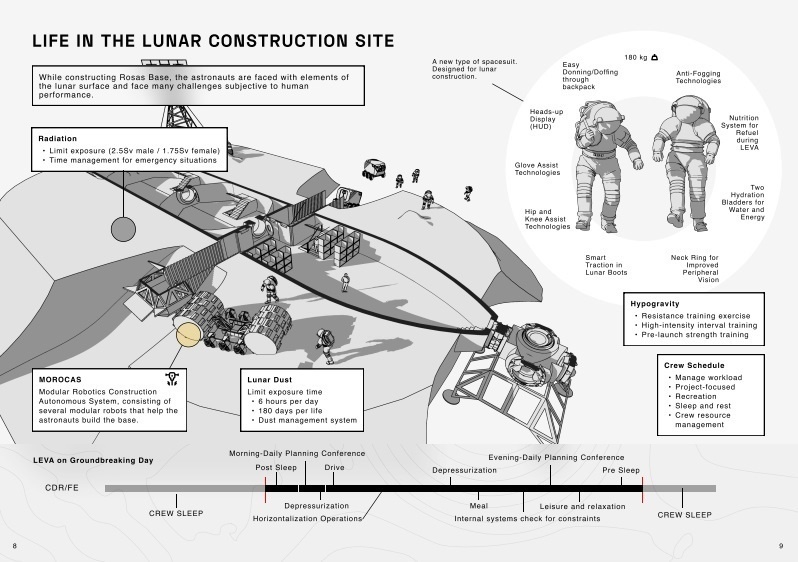By Matt Williams
Between the multiple space agencies planning to conduct crewed missions to the lunar surface, the many commercial entities who’ve contracted them to assist them, and proposals for lunar bases, the message of the modern space age is clear: We’re going back to the Moon. And this time, we intend to stay! Just like the efforts of the Apollo Era, this entails several challenges, ones that require “the best of our energies and skills.”
These challenges are leading to all sorts of innovative solutions, which recognize the need to leverage lunar resources to provide protection against the environment and see to peoples’ needs. A new proposal made by a team from the International Space University (ISU) has found a novel way to do just that. Their proposal? Use the SpaceX Starship Human Landing System (HLS) as the foundation for a lunar base.
This proposal is the work of a team from multiple universities and scientific institutes across Europe, all of whom are currently attending the International Space Univerity (ISU) in Strasbourg, France. It was also the subject of a presentation that took place at the 72nd International Astronautical Congress (IAC) in Dubai this past week (October 25th – 29th, 2021) and is the subject of a proposal paper and an official report (as well as an executive summary).

The project, titled “Solutions for Construction of a Lunar Base,” was the product of a nine-week collaborative study that was part of the ISU’s 2021 Space Studies Program (SSP). This professional development course welcomes postgraduate students and professionals of all disciplines and features a curriculum that includes policy, law, business, humanities, life sciences, engineering, physical sciences, and space applications.
As a starting point, the team considered the design of the SpaceX Lunar Starship, which the company submitted as part of a NASA competition to create a Human Landing System (HLS) for the Artemis Program. This vehicle is essentially a modified version of the Starship reusable space vehicle that Elon Musk hopes to use (along with the Super Heavy booster rocket) to conduct regular flights to the Moon, Mars, and beyond.
Like SpaceX’s Starship/Super-Heavy launch system, the Lunar Starship is designed to be fully reusable. In addition to orbital refueling, SpaceX’s lunar mission architecture also calls for the creation of fuel depots on the Moon so the Starship can make the return flight to Earth. For the sake of their project, however, the ISU team proposes using the Starship’s hull as the foundation of their base.
Charlotte Pouwels, a physicist and researcher with Airbus Defence and Space Netherlands, is a member of the ISU’s 2022 Master in Space Studies program (MSS2022). She and her team were inspired to create a concept that would enable the rapid and cost-effective construction of permanent lunar infrastructure while also allowing crews to address the challenges of living and working in the lunar environment.

“Establishing a lunar outpost requires humans to have all the provisions and equipment to sustain themselves and stay healthy, for at least the duration of a rescue mission,” she said. “This would take at least three days when coming from Earth or 7-11 days from Gateway. All of the life support systems and communications should be reliable and redundant. The problems the Starship project addresses are: crew health, social well-being, safety, communication, energy, thermal control, structural reliability, and many others.”
The plan calls for using the Starships HLS (SS Rosas) as a habitable volume for astronauts and construction crews (Rosas Base). These crews will live in these habitats for two to three months while assembling the infrastructure (with robotic assistance) for a permanent human presence. According to Pouwels, the main advantage of this proposal is that it allows astronauts to bring their habitat and necessary supplies with them:
“These challenges can be overcome if enough supplies would be delivered and installed in the outpost to be prepared for any situation. Thus our solution utilizes the current state-of-the-art transport vehicle – the SpaceX Starship Human Landing System (HLS), which is currently in development.
“Our design aims to use the vehicle’s outstanding capabilities and also its massive size to transfer space proven life-support and mission-critical systems with redundancy and spare parts. This research is unique in the way that it does not need any unproven or theoretical concepts and systems. Should the Starship be successful, this habitat can be in operation in less than five years.”

During the mission, one crewed Starships (SS 501) and the other for supplies (SS Rosas) will fly to the Moon and deploy a series of remotely operated robots – known as MOdular RObotic Construction Autonomous System (MOROCAS) – that will transition the two Starships into a horizontal position. The astronauts will then convert the interior into habitable volumes, add multi-layer insulation (MLI), and deploy all the essential operations equipment. At the same time, the robots will cover the base in a protective layer of regolith.
“The main challenge of our concept was transitioning the vehicle to a horizontal position,” said Pouwels. “While on Earth the Starship cannot support its structure being vertical, the 1/6th gravity and the large pressure difference will certainly assist in maintaining the vehicle’s shape. If this is not enough, the regolith beneath the vehicle will be piled in a way that supports it, and additional supports can be installed inside the habitat.”
The basic layout of the proposed Rosas Base (shown above) is that of a habitat established on the rim of the Shackleton crater, located in the Moon’s South Pole-Aitken Basin. The base will be covered by a 5 m (16.4 ft) layer of regolith to protect it from radiation and micro-meteorite impacts, leaving only the airlocks and the nose hatch uncovered to enable access to the interior. One of these airlocks will be transformed into an observation deck.
Thanks to its location around the Shackleton Crater, this observation deck will allow for a permanent view of the Earth on the lunar horizon. The base can also be expanded with the addition of a node around the nose hatch, permitting the crews to mate one habitat to another. The interior will be divided into three levels that span the entire length of the vehicle, including the sections previously occupied by the methane and oxygen tanks.

“While this means that the vehicle will not fly again, it does reuse the entire structure for a long-term habitat,” said Pouwels. “This results in a habitat that is almost 2500 m3 in volume (2.5 times the ISS) by only using the vehicle itself, freeing the useful payload to be used for redundant life support systems. Covering the vehicle with 5 m regolith and adding MLI to the interior will enhance the protection of the crew from micrometeorite impacts, radiation, and thermal protection. It is also the simplest form of ISRU.”
Once complete, the base will have all the amenities it needs to deal with the hazards of the lunar environment. The hull, additional MLI, and regolith layer will limit the astronauts’ exposure to radiation to within tolerable limits – 2.5 sieverts (Sv) for male and 1.75 Sv for female astronauts. The astronauts will follow a schedule that limits their Lunar Extravehicular Activities (LEVAs) to six hours a day and maintain a rigorous exercise program consisting of resistance and high-intensity interval training.
Overall, the proposal for the Rosas Base is part of a larger constellation of ideas for a “Moon to Mars” mission architecture. These missions have been in the works since the mid-2000s, as part of NASA and other space agencies plan to take the next great steps to ensure humanity’s future in space. For each and every one of these plans, says Pouwel, having a permanent lunar base is essential:
“This project is ahead of its game by using the Starship as it is being developed but not relying on any yet-to-be-proven technologies. With the reusability and mass-production of Starship, this concept of a lunar base can be quickly expanded, with many habitats linking together to create a lunar city. The basic goal of this concept is to have potential revenues or benefits from the base in the near future.”

What’s more, Pouwels and her colleagues hope that this idea will attract potential investment based on the number of applications it could have in the near future. They also hope that once one vision for a lunar outpost is realized, that this will allow for several more will follow. In this, they are undoubtedly correct. Once humans establish a foothold on the Moon, opportunities for research, expansion, investment, and commercialization will follow.
From there, it will be possible to send missions to Mars and other locations in deep space. Once we can establish a foothold on these bodies too, the dream of becoming an “interplanetary species” will become a reality!
Further Reading: Website, Report, Paper
The post New Idea: Use the Starship HLS to Create a Lunar Base! appeared first on Universe Today.

October 31, 2021 at 01:01AM
via Universe Today read more...

0 Comments